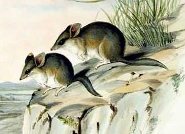 The Fat-Tailed Dunnart (Sminthopsis crassicaudata) is a mouse-like marsupial that is not on the endangered species list. It measures around 60-90mm (2.3 to 3.5 inches) and has a 45-70mm (1.75 to 2.75 inches) long tail. Its ears stand 14-16mm (0.55 to 0.63 inches) tall and all together he weighs between 10-20 grams (0.35 to 0.7 ounces), making him one of the smallest carnivorous marsupials.
The Fat-Tailed Dunnart (Sminthopsis crassicaudata) is a mouse-like marsupial that is not on the endangered species list. It measures around 60-90mm (2.3 to 3.5 inches) and has a 45-70mm (1.75 to 2.75 inches) long tail. Its ears stand 14-16mm (0.55 to 0.63 inches) tall and all together he weighs between 10-20 grams (0.35 to 0.7 ounces), making him one of the smallest carnivorous marsupials.The Fat-Tailed Dunnart's Habitat
This marsupial lives in most regions of Australia, excluding the scrubs of Victoria. The habitats in which he can be found include grasslands, shrub lands and farmlands - places where there is a lot of barren land.
The Fat-Tailed Dunnart's Diet
The Fat-Tailed Dunnart eats insects (including beetles and spider larvae), small reptiles and amphibians. Whenever there is a shortage of food, he is thankful for the fat reserves that are stored within his carrot-shaped tail.
The Fat-Tailed Dunnart's Characteristics
This animal has no known predators and is able to survive in environments that extreme to semi-arid in nature because of its physiological and behavioral characteristics. The Fat-Tailed Dunnart is nocturnal and has a 24-hour circadian rhythm. This protects him from losing energy while feeding during the high temperatures at night.
The Fat-tailed dunnart is listed as Least Concern (LR/lc), lowest risk. Does not qualify for a more at risk category. Widespread and abundant taxa are included in this category, on the IUCN Red List of Threatened Species
Countries
AustraliaSome facts about the
Fat-tailed dunnart
Adult weight : 0.015 kg (0.033 lbs)
Maximum longevity : 5 years
Female maturity :115 days
Male maturity : 159 days
Gestation : 14 days
Weaning : 69 days
Litter size : 7
Interval between litters : 94 days
Weight at weaning : 0.007 kg (0.0154 lbs)
Body mass : 0.016 kg (0.0352 lbs)
Temperature : 34.85 °C (94.73 °F)

Custom Search